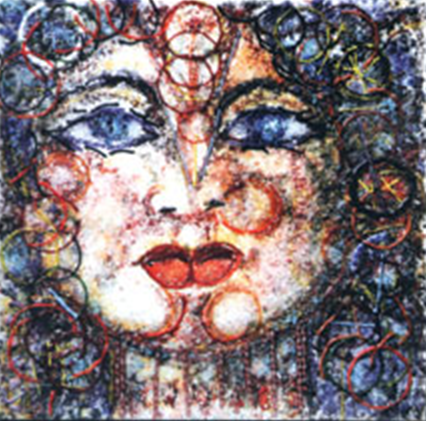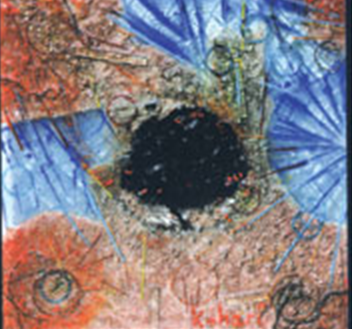Masood Kohari
This is a collection of articles archived for the excellence of their content. Readers will be able to edit existing articles and post new articles directly |
Kohari’s crystal fire paintings
By Marjorie Husain
Masood Kohari’s exhibition of crystal collages held at the Alhamra Galleries, Lahore, recently, carried the conviction of four decades of experimentation with diverse media. The culmination of over two years of preparation, the delicately textured, glowing artworks established a new, potentially exciting art chapter in Pakistan. Kohari was delighted to have the long planned exhibition mounted with the collaboration of the PNCA, and the Punjab Artist’s Association. In response to the groups of young students and their teachers visiting the exhibition who asked detailed questions about the artwork and the complex process of creativity, the artist explained his work enthusiastically and at length. Kohari had introduced his work in glass for the first time at Alhamra, during the 5th National Exhibition, held in 1984. The four intricately textured, colourful glass panels he contributed earned him the First Prize in the Sculpture/Ceramics category.
Passing through Karachi some time back, Kohari conducted a workshop and set up a kiln at the Karachi School of Art, but he is a rare visitor to the cities, focused on his work he divides his time between Gujranwala where he teaches at the Ceramic Institute and works with diverse media, and further work at home with his family in France.
Kohari’s art adventure began many years ago. Glancing through a current Bonham of Bond Street, catalogue I was amazed to see one of his paintings from the sixties: Red Sails at Sunset, and it held its own with all the stars currently much in demand. The Sixties were a time in Kohari’s life when he was, painting with oils on canvas. His first exhibition was at the PACC in ’62, and others followed. In those days he was invariably with his close friend Jamil Naqsh, and together they would explore Karachi and its environs seeking places and objects as subjects to paint.
Kohari was popular in local art circles, artists met at his place to chat in the evenings, he always attended other artists’ exhibitions and his outlook was very positive, so in 1964 when he went off to Gujranwala, he was missed on the scene. In Gujranwala he formed strong ties working with the ceramic craftsmen, learning about clay and beginning a life-long fascination with the qualities of clay and fire. In 1968, he surprised us all by mounting a spectacular ceramics show at the Karachi Arts Council. It included four brilliantly coloured, 8ft tall columns measuring 15 inches in circumference; 70 wall based reliefs, large urns, and a series of tiles he titled: War and Peace.
Professor Shakir Ali wrote at this time: “I have known Kohari as a painter but it was a pleasant surprise to see him develop as a Ceramist…In Pakistan Kohari is the first who has adopted this medium for the expression of his talent…Kohari has not finished with his experiments and I am quite sure that his future efforts will bring fruitful results.” Shakir Ali 1967.
Kohari’s desire to work with glass led him to France where he visited established glass studios and workshops, and on to the famous glass artworks centre of Marino near Venice in Italy. Wherever he went, Kohari found the artists and craftsmen extremely helpful, and generous in imparting knowledge of their art. In 1970, Kohari first exhibited his work in Paris at the Galerie Simons Badiner. Working on flat surfaces he experimented with collage elements and the `fire collages’ emerged, pieces rich with colour and texture contrived by powdered glass melting in the oven then passing through the annealing process to cool down slowly and avoid cracks. That year in France, Kohari’s work in exhibition earned positive reviews from publications such as La Monde, and La Figaro. In an art event showing the work of 500 artists at the Grande Palais, Paris, and his work was awarded an `Honorable Mention’. From that time on Kohari has divided his time between France and Pakistan, notably Gujranwala.
Through the years, he has been much in demand for commissioned work in Pakistan and his friends were intrigued by his methods. Bashir Mirza was one of a number of artists inspired by him to try their hand at working on ceramic tiles. In Karachi a fine example of Kohari’s expertise in this field can be found at the Maritime Museum where a wall of gradient pale blue tiles, 37’x17’ is displayed.
Before one entered the galleries of Alhamra to view Kohari’s work, at the entrance hung a large, mixed media work depicting `Sohni’, swimming across a dark blue river of glass shards clutching her clay ‘mudka’. This folk legend has particular connotations for the artist whose friends in Gujarat show him the `actual’ site of Sohni’s crossing. Inside the hall, numerous visitors viewing the work for the first time found several disciplined involved and asked each other how the work should be classified. They were bewildered by the unusual experience of the media and the title given to the work: Fire Paintings. Kohari attempted to explain the process. He had simplified the current exhibits by removing the clay base. Sheets of a particular kind of glass may be layered with powdered glass, wire netting, various colour and chemicals, and topped with another sheet of glass. On this upper sheet one may find elements, which in the oven fuse to create beautiful textures, air bubbles and variations that interact with light passing through the patterns. Certainly walking into the gallery surrounded by the varied designs and colours of the glass panels framed in steel, was an unusual aesthetic experience. The crystal translucence enriched by lovely shades forming abstract intervention is extremely fine. Among the abstract panels, there were image of faces veiled by wire mesh. It is always invigorating to see new ways of making art and many of the younger artists who attended the show were excited by innovations of their own to try out.
During the duration of the exhibition, Kohari was in attendance from early morning till evening, on hand to answer numerous enquiries. He appeared animated and full of energy. TV cameras came and went groups of children, art students and his old friends. One saw Abdul Hayee from Karachi at the exhibition, teachers from the Karachi School of Art, and those from Lahore. Displayed at the upper galleries, one found a series of animated, sculpted pieces composed of molten glass and animated metal wires. A comment on life as he finds it came by way of a light hearted sequence of witty sculptures depicting `spoons’ emerging from throne-like bottle shapes. Kohari spoke warmly of his friends of longstanding in Gujranwala who attended his opening. It is they who had established the Ceramics Institute in that region and through the years generously provided the facilities for Kohari’s work. He is also very attached to the local craftsmen and in his catalogue addressed a letter to them written in Punjabi.
Making plans to return to his family and working practices in France, Kohari talked of the exhibition scheduled to be displayed in Islamabad at a later date, and finally in Karachi. The artist spoke of his work as a “Life-time affair with my muse, fire and clay that brought me nearer to the people of Lahore, Gujrat, and Gujranwala.”



